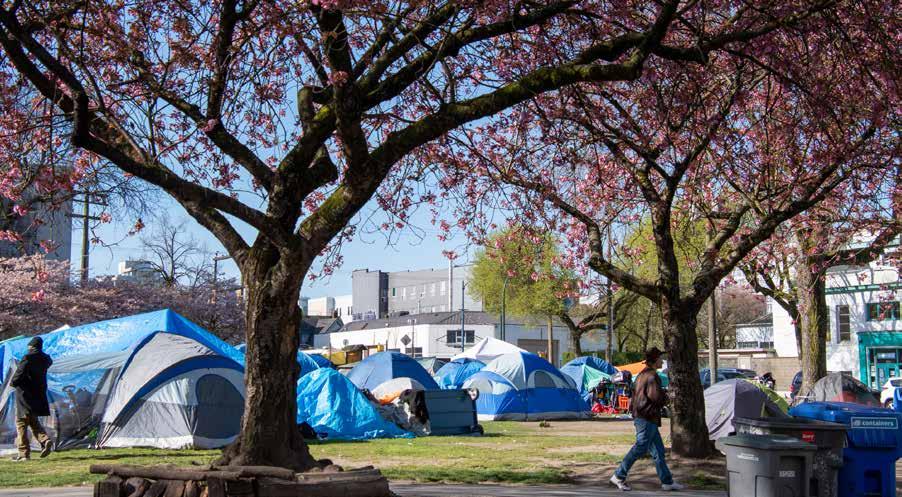
54 minute read
Law Review
In this case, Plaintiffs alleged that Defendants unlawfully seized Plaintiffs’ property in violation of the Fourth Amendment guarantee against unreasonable searches and seizures, as well as violations of due process rights.
Advertisement
By James C. Kozlowski, J.D., Ph.D.
In the case of Berry v. Hennepin County, 2020 U.S. Dist. LEXIS 201810 (U.S. Dist. Minn. 10/29/2020), a number of individuals experiencing homelessness and organizations representing individuals experiencing homeless filed suit in federal district court seeking a temporary restraining order against various public entities and officials, including the Minneapolis Park and Recreation Board (MPRB), to prevent police “sweeps” of homeless encampments in public parks throughout Minneapolis, Minnesota.
A temporary restraining order, or “TRO,” is a court order of limited duration made in the early stages of a lawsuit, which maintains the status quo of a situation until the court can hear further evidence and decide whether to issue a preliminary injunction pending final judgment after a trial to resolve a lawsuit.
During these sweeps, Plaintiffs alleged police seized and destroyed the property of persons experiencing unsheltered homelessness encamped in public parks. Plaintiffs challenged Defendants’ treatment of persons experiencing unsheltered homelessness. As noted by the federal district court, this lawsuit arose from a “confluence of two significant societal problems — homelessness and the [coronavirus (COVID-19)] pandemic.”
Facts of the Case
In this case, Plaintiffs alleged Defendants had conducted ‘sweeps’ during which Defendants had “seized and destroyed the property of persons experiencing unsheltered homelessness who currently are living in encampments in public parks throughout Minneapolis.” Defendants included: Hennepin County, the City of Minneapolis, the Minneapolis Mayor, the Minneapolis Chief of Police, the MPRB, the MPRB Superintendent, the MPRB Park Police Chief, the Hennepin County Sheriff and multiple unnamed police officers.
Plaintiffs in this action included
individual Plaintiffs and one organizational Plaintiff. The individual Plaintiffs in this action are six individuals experiencing unsheltered homelessness in Hennepin County, Minnesota, including four individuals who currently are not living on public land and two individuals who currently are doing so, within the City of Minneapolis park system. The organizational Plaintiff, Zakah, Aid and Charity Assisting Humanity (ZACAH), is a private nonprofit organization staffed by unpaid volunteers with a mission to provide financial assistance to residents of Minnesota who are on the verge of experiencing homelessness.
COVID-19 Emergency Orders
On April 8, 2020, Minnesota Governor Tim Walz issued Emergency Executive Order 20-33, which states: “Encampments should not be subject to sweeps or disbandment by state or local governments, as such sweeps or disbandment increase the potential risk and spread of COVID-19.”
On April 29, 2020, Governor Walz issued Emergency Executive Order 20-47, which clarified Emergency Executive Order 20-33 with respect to encampments, noting that “both new and existing encampments should not be subject to sweeps or disbandment by state or local governments.” State or local governments, however, could “restrict, limit or close encampment spaces” if “an encampment has reached a size or status that is a documented threat to the health, safety or security of residents.” To do so, however, a local government entity must have been “providing sufficient alternate housing, shelter or encampment space that complies with the Minnesota Department of Health’s guidance and the Centers for Disease Control and Prevention’s (CDC’s) guidance (i.e., Responding to COVID-19 Among People Experiencing Unsheltered Homelessness).”
On May 13, 2020, Governor Walz issued Emergency Executive Order 20-55, which reiterated the guidance to encampments set forth in Emergency Executive Order 2047.
Park Refuge Resolutions
The MPRB manages the City of Minneapolis park system. On June 17, 2020, the MPRB adopted Resolution 2020-253 declaring Minneapolis parks to be a refuge space for persons experiencing unsheltered homelessness. On July 15, 2020, the MPRB adopted Resolution 2020-267, which limited the number of Minneapolis parks that could be refuge sites to 20 and limited the number of tents located at each site to 25 through a permit process.
In August and September 2020, Minneapolis Park Police disbanded one of several Powderhorn Park encampments, along with the encampments at Peavy Park, Kenwood Park and Elliot Park. Further, the MPRB had issued public statements that “due to health and safety concerns, the MPRB will not be extending temporary encampment permits into cold weather, anticipated to be sometime in October.”
Motion for Temporary Restraining Order
suit on October 19, 2020, alleging that Defendants unlawfully seized Plaintiffs’ property in violation of the Fourth Amendment guarantee against unreasonable searches and seizures, as well as violations of due process rights guaranteed by the 14th Amendment.
In their lawsuit, Plaintiffs also filed a motion for a temporary restraining order “to prevent Defendants from taking certain actions against individuals who are experiencing unsheltered homelessness and living in public parks in Minneapolis and throughout Hennepin County,” which included: (1) clearing encampments in public parks within Hennepin
County, (2) seizing Plaintiffs’ property and the property of the putative class members [i.e., affected homeless individuals] without adequate pre-deprivation notice, and (3) destroying Plaintiffs’ property and the property of the putative class members.
In particular, Plaintiffs were seeking a temporary restraining order from the federal district court, “enjoining Defendants from sweeping encampments in violation of Executive Order 20-47 signed by Governor Walz on April 29th.”
Temporary Restraining Order Factors
As cited by the court, the “Federal Rule of Civil Procedure 65(b) authorizes a district court to grant injunctive relief in the form of a temporary restraining order.” In determining whether this “extraordinary remedy” is warranted, the federal district court would consider the following four factors as applied to the “movant,” in this case the Plaintiffs:
(1) the threat of irreparable harm to the movant, (2) the likelihood that the movant will succeed on the merits, (3) the balance between Plaintiffs’ alleged harm and the injury that an injunction would inflict on other parties, and (4) the public interest.
As noted by the court, “the purpose of a temporary restraining order is to maintain the status quo” while claims are being resolved by the court. Further, “the burden rests with the moving party to establish that injunctive relief should be granted.”
Accordingly, the federal district court would first determine whether Plaintiffs had established “the threat of irreparable harm” in the absence of a temporary restraining order. As described by the court: “Irreparable harm occurs when a party has no adequate remedy at law, typically because its injuries cannot be fully compensated through an award of damages.” Further, the court acknowledged Plaintiffs had the burden “to establish the need for injunctive relief to prevent irreparable harm.” In so doing, Plaintiffs had to demonstrate “the harm is certain and great and of such imminence that there is a clear and present need for equitable relief.” Moreover, the court acknowledged that a “mere possibility of harm is insufficient” to issue the extraordinary remedy of a temporary restraining order.
In this particular instance, the question before the federal district court was “whether any plaintiff would suffer irreparable harm if this Court does not grant a temporary restraining order enjoining Defendants from ‘sweeping’ encampments.”
Irreparable Harm Requirement
In the complaint, the organizational Plaintiff, ZACAH, alleged that board members and volunteers have dedicated countless hours to place people in emergency hotel rooms. ZACAH further alleged that, of the $115,715 in donations it has received, the organization has spent approximately $113,000 to pay for hotel rooms for displaced people on an emergency basis.
ZACAH argued that this expenditure has prevented it from using those funds to advance ZACAH’s core mission to “support people in transitioning from a state of vulnerability, back toward a path of sustainability.” ZACAH acknowledged: “Diverted resources, however, can be compensated through money damages.”
As noted by the federal district court, “costs associated with litigation and use of scarce financial and human resources did not establish irreparable harm.” In particular, the court found an organization’s diversion of resources “amounts to no more than a loss of money and time, which is generally not irreparable harm.” In this instance, ZACAH had effectively conceded that it could be compensated for the financial harm it was allegedly suffering through an award of money damages, assuming ZACAH was able to prevail on the merits of its lawsuit in further trial proceedings. As a result, the federal district court held that ZACAH had not established that it would suffer irreparable harm absent the court’s issuing a temporary restraining order. The federal district court, therefore, denied ZACAH’s motion for a temporary restraining order.
Irreparable Harm: Real or Speculative?
As to the individually named Plaintiffs, the federal district court noted that “the record establishes that some of the individually named Plaintiffs currently are living in encampments and some are not.” In their lawsuit, the individual Plaintiffs were seeking “injunctive relief enjoining Defendants from clearing the encampments in Hennepin County and from seizing and destroying the property of individually named Plaintiffs and the property of the putative class members [i.e., a potential group of similarly situated individuals] in the future.”
Individual Plaintiffs not currently living in encampments claimed they “might resume living in an encampment in Hennepin County at some point.” Since these Plaintiffs were not subject to possible removal from encampments, the federal district court found it would be improper to grant a temporary restraining order to address such “speculative harm”:
The harm as alleged by the
Non-Encampment Plaintiffs in the form of removal from encampments is speculative because they currently do not live in encampments. Because speculative
harm is not irreparable harm, the
Non-Encampment Plaintiffs have not demonstrated that they will suffer irreparable harm absent a temporary restraining order from the Court.
As noted by the court, two of the other individually named Plaintiffs do “currently reside in encampments.” These “Encampment” Plaintiffs alleged that they did not know where they would live if Defendants forced them to leave their encampments in B.F. Nelson Park and Martin Luther King Jr. Park. Accordingly, these Encampment Plaintiffs argued they would “suffer irreparable harm in the form of evictions from their encampments if this Court does not issue a temporary restraining order”:
The Encampment Plaintiffs contend that, if the encampments where they reside in their tents are disbanded, the Encampment
Plaintiffs will lose their shelter.
And they maintain that loss of housing resulting from an eviction can constitute irreparable harm.
In addition, were they to lose essential possessions, these Encampment Plaintiffs had further argued that the loss would be both devastating and traumatizing. While not minimizing this hardship, the federal district court noted that Plaintiffs had not argued that the harm arising from such a property loss would necessarily be irreparable. On the contrary, the court found the possible seizure or destruction of the Encampment Plaintiffs’ personal property was highly speculative and any such harm was not irreparable because lost personal property could be returned or compensated through monetary damages.
Accordingly, in the opinion of the federal district court, Plaintiffs had failed to demonstrate that the possible loss of essential personal possessions would constitute the requisite irreparable harm to warrant a temporary restraining order.
In addition, Plaintiffs had argued that they would suffer irreparable harm based upon the identified threat of contracting COVID-19 in a shelter. The federal district court rejected this argument. As noted by the court, “the record reflects that the COVID-19 infection rate among individuals in Hennepin County shelters is lower than the infection rate for the general population.” Moreover, under the circumstances of this case, the court found “no deaths due to COVID-19 have occurred among individuals in Hennepin County Shelters.”
Potential Harm Mitigation
In response to Plaintiffs’ claims, Defendants had argued Plaintiffs would not be harmed irreparably if the MPRB determined that those encampments where Plaintiffs reside should be removed. If Plaintiffs’ encampments were subject to removal, MPRB stated it would do so in the same manner as it has with the other encampments. Specifically, MPRB would make a determination that the encampments have become health and safety risks to the campers and the public. Moreover, MPRB would ensure “there is adequate shelter elsewhere” for Encampment Plaintiffs.
In addition, in the event of any encampment removals, Defendants pledged to provide “both notice and outreach services.” According to Defendants: “If shelter space is available for all persons removed from the encampments, the possible harm that the Encampment Plaintiffs might face if encampments are disbanded would be mitigated.”
Further, the City of Minneapolis and Hennepin County claimed shelter options were available. Moreover, the Director of the Hennepin County Office to End Homelessness indicated: “Hennepin County has committed to finding shelter for all families with children, even if family shelters are at capacity.” According to Hennepin County, between July 1, 2020 and October 21, 2020, there were “unused beds for single women every night.” Beginning in September 2020, Hennepin County acknowledged that “shelters for single men in Hennepin County had begun to reach their capacity more frequently.” That being said, Hennepin County claimed that “new beds do become available each day for single adult men.” Accordingly, Hennepin County maintained that “single adult men experiencing homelessness in Hennepin County might be able to find shelter on any given night.”
While Hennepin County claimed shelter options were available if Encampment Plaintiffs were displaced, the federal district court found these prospects were not cer-
tain. Further, the court acknowledged: “The potential harm that the Encampment Plaintiffs face as a result of possible disbandment is not minimal.” In the opinion of the court, potential harm, however, was insufficient to satisfy the “certain and concrete” irreparable harm requirement to warrant injunctive relief in the form of a temporary restraining order.
As noted by the federal district court, Defendants had declared that “encampments will not be removed unless three conditions are met”: (1) the MPRB determines that a health and safety risk to the encampment residents exists, (2) a health and safety risk to the public exists, and (3) adequate shelter exists elsewhere.
Consistent with this declaration, the MPRB Park Police Chief testified that the removal of encampments had been undertaken only when there has been an “actual and demonstrated threat to the public safety or health of camp residents or the neighbors and neighborhoods of the park because of the encampment.” Further, these encampment removal actions were only undertaken after the MPRB superintendent “gave explicate direction after he was satisfied that public health and safety were endangered and that adequate housing for homeless persons existed in the community.” In addition, “when an encampment is to be disbanded,” the MPRB Director of Community Outreach testified that “Community Outreach employees work with the inhabitants and permittees to assist them in finding alternative housing.”
Based on these representations and sworn declarations, Defendants claimed that “the Encampment Plaintiffs will not experience irreparable harm in the event that the MPRB disbands an encampment after the aforementioned circumstances have been established.”
No Evidence of Irreparable Harm
In the opinion of the federal district court, Plaintiffs had “not presented any evidence that persuasively contradicts Defendants’ evidence and representations, so as to establish that Plaintiffs’ alleged harm is sufficiently certain and concrete.” Accordingly, the court concluded that “the Encampment Plaintiffs have not met their burden of demonstrating irreparable harm as required to secure a temporary restraining order.”
In reaching this conclusion, the federal district court recognized the robust efforts of volunteers, nonprofit organizations and governmental entities to assist those who face unsheltered homelessness in the local Twin Cities community, including ZACAH, the Mid-Minnesota Legal Aid and the American Civil Liberties Union, as well as Hennepin County, the City of Minneapolis and MPRB, along with numerous other nonprofit organizations and volunteers. Further, the court acknowledged the prevalence of unsheltered homelessness in the Twin Cities had increased since the beginning of the COVID-19 pandemic:
Both experiencing and addressing unsheltered homelessness are grave challenges in the best of times. The COVID-19 global pandemic has both increased the number of people experiencing unsheltered homelessness and further complicated the means of addressing unsheltered homelessness in light of the CDC’s recommendations to practice social distancing and elevated sanitation procedures.
That being said, the legal issue before the federal district court was not “how best to address unsheltered homelessness.” On the contrary, as identified by the court, the sole issue for judicial consideration was a procedural issue; i.e., “whether Plaintiffs have met the legal standard necessary to secure a temporary restraining order.” In so doing, the federal district court acknowledged that depriving Plaintiffs of a place to live might constitute irreparable harm within the context of a motion for a temporary restraining order. However, under the circumstances of this particular case, the federal district court found Defendants had pledged to mitigate any harm to Plaintiffs by ensuring the availability of an alternative place to live when encampments in public parks had to be removed due to COVID-19 related health and safety concerns.
Conclusion
Having found Plaintiffs had failed to establish the requisite irreparable harm to warrant injunctive
relief against Defendants, the federal district court denied Plaintiffs’ motion for a temporary restraining order “without prejudice.” Accordingly, if Plaintiffs could show irreparable harm based on Defendants’ failure to honor their commitment to provide shelter alternatives to encampment removals, Plaintiffs could renew their motion for a temporary restraining order.
The reasoning of the federal district court in this particular case regarding the availability of alternative shelter for individuals experiencing homelessness residing in public parks was consistent with the general view of federal courts on the homeless issue. This approach was apparent in the opinion of the U.S. Court of Appeals for the Ninth Circuit in the case of Martin v. City of Boise, 920 F.3d 584 (9th Cir. 4/1/2019). In this case, the federal appeals court held the Eighth Amendment’s prohibition on cruel and unusual punishment bars a city from prosecuting people criminally for sleeping outside on public property, in particular public parks, when those people have no home nor other shelter to go to. The City of Boise had a Camping Ordinance (Boise City Code § 9-10-02) that made it a misdemeanor to use “any of the streets, sidewalks, parks or public places as a camping place at any time.” The Camping Ordinance defined “camping” as “the use of public property as a temporary or permanent place of dwelling, lodging or residence.” While the Eighth Amendment would not require the city to provide sufficient shelter for the homeless, the Ninth Circuit held the government cannot criminalize indigent people experiencing homelessness for sleeping outdoors on public property, like public parks, as long as there is no option for sleeping indoors.
See also: “Camping Ordinance Criminalized Homeless Status,” James C. Kozlowski, Parks & Recreation, Jul. 2019, Vol. 53, Iss. 7 mason.gmu.edu/~jkozlows/lawarts/ 07JUL19.pdf
James C. Kozlowski, J.D., Ph.D., is an Attorney and Associate Professor in the School of Sport, Recreation and Tourism Management at George Mason University (jkozlows@gmu.edu). Webpage with link to law review articles archive (1982 to present): mason.gmu.edu/~jkozlows.
NRPA SOCIAL MEDIA
@NationalRecreationandParkAssociation @nrpa_news @nrpa National Recreation and Park Association
NRPA
CONNECT
nrpaconnect.org
nrpa.org/connect-app
Blog
nrpa.org/blog
parksandrecreation.org @parksrecmag openspaceradio.org
(or your favorite podcast app) @openspaceradio
FOR 2021 3030UNDER
Parks & Recreation magazine and NRPA’s Young Professional Network launch a new program recognizing the 30 best and brightest young park and recreation professionals in the field
By Michael Biedenstein, CPRP, AFO
NRPA’s Young Professional Network (YPN) and Parks & Recreation magazine are proud to launch our first-ever “30 Under 30.” This new recognition program is a joint effort honoring 30 of the top young park and recreation professionals who, quite frankly, serve as everyday superheroes in their respective communities. More than 100 nominations were received, forming a diverse group of nominees from 29 different states, one Canadian province and one U.S. Navy aircraft carrier. The selection committee evaluated the nominations on one or more of the following criteria: • Impacts on the agency’s community and service population • Contributions to the professional development of the field of parks and recreation • Innovative ideas, programs and/or research in the field of parks and recreation
Following are the profiles of this inaugural class of the Parks & Recreation 30 Under 30. Their stories are full of passion, creativity, talent and perseverance. It is truly inspiring to see the profound impacts that these individuals are having in their communities and the field of parks and recreation.
Thank You to Our 30 Under 30 Selection Committee
Chris Bass, CPRP
Douglasville Parks and Recreation (GA)
Michael Biedenstein, CPRP, AFO
St. Louis County Parks and Recreation (MO)
Kate Connell, CPRP, AFO
Iowa City Parks and Recreation (IA)
Sam Mendelsohn
Greenfields Outdoor Fitness
Lisa Paradis, CPRP
Berry Dunn
Ronnetta Spalding
Indy Parks and Recreation (IN)
Anne-Marie Spencer
Playcore
3030UNDER

Kendra Beaver, 27
Recreation Coordinator, City of Excelsior Springs Parks and Recreation (MO) Kendra Beaver graduated from Hannibal-LaGrange University with a bachelor’s degree in recreation management. As recreation coordinator for Excelsior Springs Parks and Recreation, Beaver has formed one of the nation’s leading P&R esports programs. In addition to serving dozens of participants each week in the city, what she is doing to educate, inform and promote this new recreation pursuit nationwide will have a profound impact on the field. She has presented at several national and state conferences, including those hosted by the Missouri, Wyoming and Wisconsin park and recreation associations. She is an advocate and speaker for NRPA’s YPN.
Eduardo Campos, 28
Marketing and Communications Manager, Mountain Recreation Metropolitan District (CO) Eduardo “Eddie” Campos understands his community and its challenges. In college, he helped to connect people to their community to prevent social, emotional and mental health issues. This experience, paired with his community knowledge, sets Campos apart from the typical marketing manager. He reaches into local Latino neighborhoods and personally connects with individuals to learn how to better serve their needs. What’s more, Campos is leading a diversity, equity and inclusion (DEI) steering committee for Mountain Recreation that is intended not only to send staff members on their own personal DEI journeys, but also to share his organization’s journey with the public.

Amy Collier, 30
Grants Admininstration Specialist, City of Memphis Parks (TN) In her three years with the City of Memphis, Amy Collier has elevated the Parks Division with every project she takes on. As grants administration specialist, Collier has leveraged more than $2 million in grant funding. She has forged new relationships with local and national funders to benefit Memphis’ park system. While grant writing is naturally competitive, she truly desires the success of all park departments. Collier also advocates for neighborhood parks as critical infrastructure to benefit the city. Her passions for community and equity through parks are infectious and exactly the values that park professionals should strive to uphold.
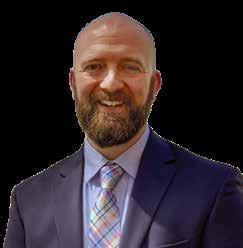
Tanner Deisch, 29
Recreation Supervisor — Aquatics, Town of Chapel Hill Parks and Recreation (NC) Tanner Deisch already has established himself as a leader in P&R. He is aquatics supervisor for Town of Chapel Hill Parks and Recreation and served as the chair of the NRPA Aquatics Network, where he introduced new ideas and grew group membership. Earlier in his career in Greensboro (NC), Deisch developed partnerships with the Greensboro Housing Authority, UNC–Greensboro and the Greensboro Aquatic Center to increase the number of lifeguard staff from underrepresented populations. One noteworthy program that he developed entailed providing opportunities for teenagers living in public housing to develop the swimming skills necessary to become certified as lifeguards.
Chris Curtis, 26

Esports Coordinator, South Suburban Parks and Recreation (CO) The impact Chris Curtis has made on the community in just one year with South Suburban Parks and Recreation has been astronomical, especially through his creation of an incredible esports lounge. Curtis continues to build new programs that offer an outlet for children and adults in the community through esports and competitive video games. An expert in the field, Curtis provides esports tournaments for the local Tekken and Super Smash Bros. competitive communities for no profit. He not only has changed the landscape of P&R, but also has used the esports lounge to help promote sanctioned esports in high schools.
Matthew Denton, 27
Parks and Recreation Director, City of Smithville Parks and Recreation (MO) In just two-and-a-half years, Matthew Denton has worked his way up from recreation and marketing manager to P&R director for City of Smithville. Denton is attentive to his team and leads by example with his strong work ethic. As director, he has developed new trails systems, made campground enhancements in all 83 campsites, made bathroom and shower house upgrades and repairs, added livestreaming cameras at ballfields, and more. Denton is a member of professional organizations, including NRPA and his state P&R association, MPRA, where he currently serves as MPRA Sports Section secretary/treasurer and MPRA Region 1 membership chair.
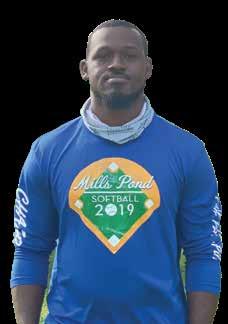
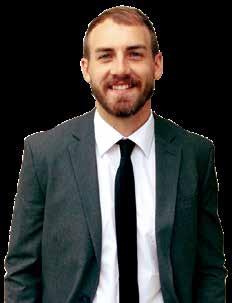
Nigel Dooling, 27
Senior Recreation Program Coordinator, City of Fort Lauderdale Parks and Recreation (FL) In March 2020, Fort Lauderdale’s parks shut down due to the coronavirus (COVID-19) pandemic, which meant no play for adult softball leagues. However, Nigel Dooling, senior recreation program coordinator, and his counterpart were confident that play could take place in a safe manner. They presented guidelines to the administration. In June, the agency’s adult softball leagues resumed. Seeing the enjoyment of a simple game of softball by participants encouraged Dooling and his counterpart to keep the leagues running in a safe environment. It was clear that participants not only wanted to play, but also needed this outlet.
Becky Dunlap, 29
3030UNDER Consultant, GreenPlay, LLC (GA) In 2017, Becky Dunlap launched “Becky Talks Parks,” a podcast focused on P&R trends and challenges, and shared knowledge that encouraged listeners to have an increased positive impact on communities. Dunlap eventually changed the podcast’s name to “Let’s Talk Parks,” to be more inclusive and impactful. Through her current work with GreenPlay, LLC, she helps agencies strive to meet the ever-changing needs of their communities. Dunlap champions gender equity in P&R and dedicates her efforts toward creating platforms and opportunities for women to support each other personally and professionally. She is a member of the Women in Parks and Recreation group.

Lauren Eck, 27
Recreation Specialist III, Fairbanks North Star Borough Parks and Recreation (AK) In 2017, Laura Eck began working for Fairbanks North Star Borough Parks and Recreation as a recreation specialist. This was a new position and other than swim lessons, essentially no programming was being offered to the community. Given few staff, resources and funds, Eck worked hard to build a much-needed programming department. Her expertise lies in creating programs and events, coordinating marketing and graphic design efforts, and leading staff, interns and volunteers. She has launched a variety of programs, including Mess Makers, a parent-tot art program in partnership with the local Children’s Museum, and pop-up playground programs in low-income areas.


Joshua Edwards, 27
Director of Recreation, Blue Island Park District (IL) As director of recreation, Joshua Edwards made a deliberate decision to hire interns from nearby colleges as well as coordinators with diverse backgrounds. He believes it’s critical for P&R to have minority representation in Blue Island. As a result, interns and coordinators gain experience in recreation programs, special events and stewardship. Edwards leads workshops, internships and mock interviews to educate students on how they can make a difference within the profession. He contends this helps students take what they learn in the classroom and apply it in the field. What’s more, Edwards mentors college graduates and young professionals entering the P&R profession.
Geordie Emmanuel, 25
Deputy Director of Recreation, Town of East Longmeadow (MA) When George “Geordie” Emmanuel joined the Town of East Longmeadow’s P&R department as deputy director of recreation, its programming options exploded. Emmanuel added an adventure camp for teens and non-sports-related programs — including a safe@home class, STEM classes and an afterschool program that started after COVID-19 began. He also ran 13 weeks of day camp to meet the needs of parents with no childcare options. Emmanuel creates a fun working environment and motivates staff to give it their all. He maintains an excellent balance between youthfulness and strong professional standards.

Sandip Gill, 24
Middle Years Coordinator, DIVERSEcity Community Resources Society (BC, Canada) As middle years coordinator, Sandip Gill works with refugee children ages 6 to 12 in the First Steps Early Years Refugee Program. Many of these children and their families fled war-torn countries and witnessed traumatic incidents. Gill works with them to establish a positive, caring adult relationship with each child. She introduces them to P&R opportunities in the community that are accessible, free or low cost. She also takes the children to community events so they can become integrated into Canadian society and learn to be engaged members of their new communities.
Brett Gordon, 27
Inclusion Specialist, City of Virginia Beach Parks and Recreation (VA) Social equity is not a foreign concept to Brett Gordon. As an inclusion specialist, he lives it every day. In 2018, Gordon coordinated a new special event, “Unity Week,” which celebrates our differences and embraces the unique aspects that set us apart with positivity and acceptance. The Virginia Recreation and Parks Society recognized Unity Week as the Best New Special Event for 2018. In 2019, Gordon compelled other city departments to move the initiative forward by wearing orange, sharing special unity messages and sponsoring community activities. Almost overnight, this event went from a department initiative to a citywide, all-departments event.

Kira Haley, 29
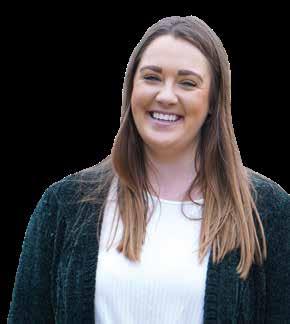
Lake Recreation Manager, Helix Water District (CA) In 2014, Kira Haley’s recruitment as lake recreation manager was Helix Water District’s last effort to find someone who could lead staff in creating a self-sustaining operation that serves the public with outdoor experiences. To help rebrand the lake, Haley created a new website and marketing plan, built a social media presence and reached out to the community. Infrastructure needs at the campground and lake were addressed by creating plans for replacement and renovation and expanding offerings. A short time after her hire, the lake was recovering all operating expenses. The campground remained in operation, allowing the lake and campground to remain open for many years to come.
Nicolette “Niki” Hoesman, 27
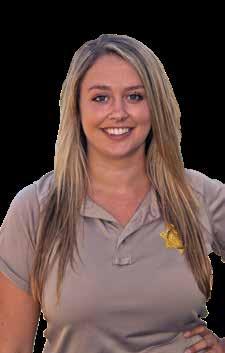
Community Program Coordinator, Urbana Park District (IL) Nicolette “Niki” Hoesman has been at the Urbana Park District for three years and is always thinking first about what kids would want to do. Hoesman has been a large part of the park district’s “You Belong Here” initiative and has focused on making sure everyone feels welcome. She has been in charge of the park district’s arts programming, and has always looked for ways to get the most out of her budget. During the community’s COVID-19 lockdown, she began teaching virtual American Sign Language classes for kids and running a Kids Craft Club on Zoom for which she delivered supplies to their houses and then did projects over the internet with them. Hoseman’s creativity and dedication to providing children with safe and fun activities are boundless!
Taylor Hooker, 26
Alex Hurdle, 29


3030UNDERRecreation Therapist, Veterans Healthcare Administration (MN) Taylor Hooker is a passionate advocate for our veterans and is dedicated to improving their quality of life. She highlights the use of recreation and leisure as key components of a healthy lifestyle for veterans and their families. Her current work focuses on advocating for and assessing the use of Equine Assisted Services for veterans. At the Veterans Healthcare Administration, she promotes using evidence-based practices for those interested in bringing Equine Assisted Services to their Veterans Affairs locations. During COVID-19, Hooker worked with her colleagues to transform these services into virtual formats, including leisure education, stress management and health coaching.
Recreation Coordinator, City of Durham Parks and Recreation (NC) Alex Hurdle is dedicated to the P&R field, especially as it relates to public health. Hurdle serves on community advisory boards, including the Duke Health and Durham County Health Department, to ensure P&R is taking an active role in improving community health. He has created programming to address issues relating to food insecurity, diabetes and food access, and willingly shares his knowledge with other P&R professionals. Along with his work on public health, Hurdle has served on the NRPA Certified Park and Recreation Professional Exam Committee, which helps shape the exam that dictates the profession’s standards.
Matthew Kerns, 26
At Large — Park and Recreation Professional, Formerly with Metro Parks Tacoma (WA) Matthew Kerns was facility supervisor for South Tacoma Activity and Recreation Center when COVID-19 hit. The facility remains closed due to pandemic restrictions, which meant he lost his job among 40 other staff. However, Kerns has found ways to volunteer with the Washington Recreation and Parks Association. He helped design and implement a survey that studied the impacts of COVID-19 on the state’s P&R agencies. Kerns also organized a community drive-in movie series this past summer, which allowed families to safely recreate. With only three staff working the event, laid-off and furloughed staff volunteered each weekend to help make the movie series successful.
Rebecca Lackey, 28
Recreation Specialist I, City of Virginia Beach Parks and Recreation (VA) Rebecca Lackey is an inspiration and an amazing team member in the City of Virginia Beach’s Parks and Recreation Department. She makes contributions to the agency’s Commission for Accreditation of Park and Recreation Agencies submission, teaches at local meetings and at the Virginia Parks and Recreation Society Conference, and works on departmental committees. Lackey also served on one of City of Virginia Beach P&R’s Strategic Initiative Teams. She was the youngest member and the only person selected who was not in an executive or management position. This was a great testament to her character and leadership in the community.

Sarah Larson, 23
Deputy Superintendent, Bristol Parks, Recreation, Youth and Community Services (CT) As the deputy superintendent of Bristol Parks, Recreation, Youth and Community Services, Sarah Larson provides access to essential services and park facilities that meet the community’s diverse needs. She is the youngest deputy superintendent in department history. Larson has prioritized centering diversity, equity and inclusion (DEI) in the agency’s initiatives, creating a DEI committee to review departmental policies and practices, developing the city’s first Land Acknowledgement to affirm the municipality and department as stewards of the land of the Tunxis Peoples, and collaborating with the Commission for Persons with Disabilities to implement strategies of universal design in programs, facilities and parks.
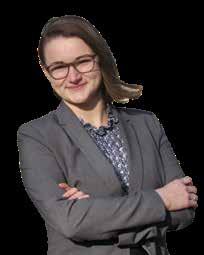
Cameron Levis, 27
Special Populations Instructor, City of Bowling Green Parks and Recreation (KY) Cameron Levis’ passion for P&R is rooted in a love for serving people with disabilities, ensuring they are afforded the same opportunities to pursue recreation and sport as their peers. He is a special populations instructor for City of Bowling Green Parks and Recreation. While hosting Bowling Green’s first-ever wheelchair basketball tournament, Levis met an athlete from Cincinnati who was playing in his first tournament. The man was a gunshot victim paralyzed from the waist down with limited mobility in his upper body. This interaction, along with so many others over the years, provides Levis with motivation at work every day.
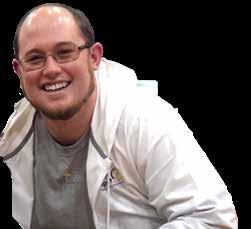
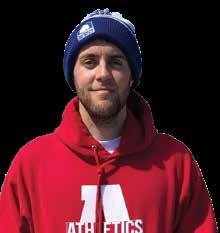
Adam Lewandowski, 29
Athletic Manager, Wheaton Park District (IL) Adam Lewandowski has made a significant impact in Wheaton and P&R. He has provided and expanded baseball, softball, football, cheer, rugby, adult softball, field hockey and sport camps to more than 5,000 participants annually. Lewandowski also oversees the two community manmade ice rinks, favored by the community, attracting almost 30 participants per hour of operation. He has been very innovative in the community — starting a new field hockey program, launching a new wrestling program, streamlining communication with part-time staff through a mobile app, and implementing an Ice-A-Palooza event that drew more than 1,500 people in just its second year.
AJ McCage, 29
Community Recreation Supervisor, City of Hopewell Recreation and Parks (VA) AJ McCage is a certified therapeutic recreational specialist who serves as community recreation supervisor at Hopewell Recreation and Parks, where she oversees and facilitates programming in all areas, including early education, seniors, special needs and summer camp. Within the first few months of her employment, she developed several classroom programs and currently serves as a member of the Special Education Advisory Committee for Hopewell schools. Her involvement with Jack-O-Lantern Jamboree, a community-wide Halloween event with an emphasis on sensory stimulation and special needs adaptation, helped Hopewell garner the Best New Special Event Award at Virginia Recreation and Parks Society’s 2019 state conference.


Angel Obert, 29
3030UNDER Assistant Director of Parks and Recreation, Unified Government of Wyandotte County and Kansas City (KS) As the assistant director at Unified Government’s Parks and Recreation Department, Angel Obert is very active in the community she serves. In her spare time, Obert volunteers as a youth sports coach. She has been indispensable in many projects that have had proven, extraordinary impacts on P&R and the community. These projects include opening the county’s first all-inclusive playground and being one of five recipients out of 200-plus applicants to be awarded a grant for the city’s first dog park. She also oversaw implementation of a new software that is transforming the department’s ability to serve the community.
Maxime Pierre, 28
Deputy Director, City of Little Rock Parks and Recreation (AR) Prior to coming to Little Rock (AR), Maxime Pierre worked for the City of Asheville (NC) as a recreation facility manager overseeing a senior center. While there he saw opportunities to integrate youth into the facility to create an intergenerational center and to develop equitable programming for low-income youth of color. Pierre also started Asheville’s esports league, reaching more than 80 participants the first weekend after the program launched. As the newly appointed deputy director of parks and recreation with the City of Little Rock, Pierre has overseen the reopening of recreation centers by implementing innovative safety measures.
Bianca Posada, 28

Program Director, Oakland, Parks, Recreation and Youth Dev. (CA) As program director for Oakland, Parks, Recreation and Youth Development (OPRYD), Bianca Posada has made numerous contributions, such as serving as the department’s citywide public contact for inclusion-related inquiries, resources and services; leading a robust Teen Inclusion Program; providing technical assistance to all internal program sites related to inclusion services; and proactively reaching out to sites offering assistance and resources. Posada also has assisted with the planning and facilitation of an early childhood program; and has created training/ resources for OPRYD that addresses such topics as accommodations and modifications for work, events and programs, and positive behavior strategies that can be used with all youth.
Julia Robson, 30

Conservation Biologist, Waukesha County Parks and Land Use (WI) As a conservation biologist, Julia Robson has the distinct duty of maintaining the natural areas and wildlife in Waukesha County. However, she is not just committed to her daily work, but also dedicated to the field of conservation. Her work has been recognized by the Wisconsin Department of Natural Resources, her alma mater University of Wisconsin-Milwaukee and other organizations. What is most impressive about Robson is her commitment to ideals greater than herself. In 2017, she and a fellow explorer walked 343 miles from Milwaukee to the shores of Lake Superior, in an effort to raise awareness about conservation of the great lakes.
Marisa Sedlak, 28
3030UNDER Recreation Activities Coordinator, Town of Beech Mountain Parks and Recreation (NC) Marisa Sedlak is recreation activities coordinator for Town of Beech Mountain Parks and Recreation Department (BMPRD). She also serves as camp director for BMPRD’s Camp Buckeye summer camp. Sedlak is always thinking of ways to establish programs and events that will be self-sustaining, long lasting and a good use of resources. She established the Beech Mountain Water Conservation Education Program to help educate community members on the importance of the river systems and their relationship to Beech Mountain. Sedlak also established BMPRD’s Volunteer Trail Guide Program to increase access to the trail system on Beech Mountain and meaningfully engage volunteers.
Felicia Trainor, 30
Facility Coordinator, City of Cooper City Recreation (FL) Felicia Trainor’s recreation career began four years ago. Her vast accomplishments have exceeded expectations and will have a lasting impact on her department and community. Under Trainor’s command as the recreation program specialist, the City of Cooper City’s special event attendance increased by 60 percent. She not only enhanced the city’s programs, but also expanded community involvement with larger capacity venues. Furthermore, she created an “At the Park Campaign” initiative to encourage residents to meet, “At the Park.” Making her career development a priority, Trainor was promoted to facility coordinator and became an NRPA Certified Park and Recreation Professional in 2019.

Paula Willis, 30
Parks and Recreation Director, South Fayette Township Parks and Recreation (PA) As South Fayette Township’s first female P&R director, Paula Willis has innovatively created and expanded recreational opportunities, as well as advanced and established park amenities. As a one-person department with limited resources, she developed creative approaches to position recreation programs and parks as essential public services. South Fayette had limited programming with 20 programs offered annually; however, she expanded this to 42 in 2016 and 88 in 2017, diversifying recreational opportunities. Program revenue increased from $22,412 in 2015 to $55,828 in 2016 and $71,342 in 2019. Having no community center, Willis worked with fire departments, schools and other organizations to utilize their facilities.
To hear Michael Biedenstein and Hayley Herzing, NRPA’s senior manager of membership, talk more about these “30 Under 30” young park and recreation professionals, tune in to the February bonus episode of Open Space Radio at nrpa.org/February2021BonusEpisode.
Michael Biedenstein, CPRP, AFO, is Park Program Services Division Manager for St. Louis County (Missouri) Parks and Past Chair of NRPA's Young Professional Network (mbiedenstein@stlouisco.com).
Worth the Wait
— the Sandorf Park Renovation Is Complete!

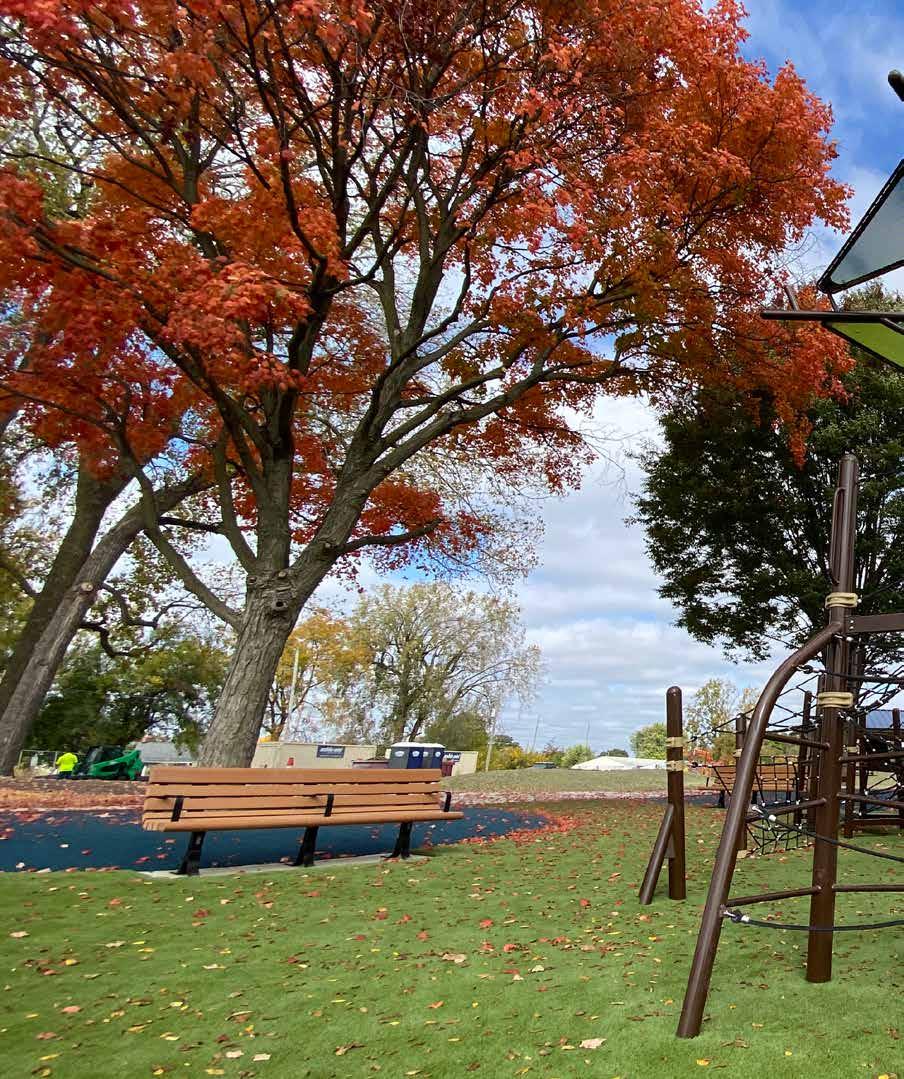
The newly renovated Sandorf Park in Indianapolis, Indiana, features updated amenities that serve both the local school’s students and the local community.

City of Indianapolis overcomes environmental challenges to restore a community’s beloved public park
By Paula M. Jacoby-Garrett
Located on the southeast side of Indianapolis, Indiana, Sandorf Park has been part of the greater Indianapolis community since 1959. Originally just an open field, over the years, facilities have been added to the park, such as a playground, basketball and tennis courts, and parking. In 1968, a school was added adjacent to the park. Since then, the park served both the school’s students and the local community, but over time, these facilities degraded, and an update to the site was greatly needed.

Three years ago, a Sandorf Park renovation was planned and designed with the needed permissions, donations and funding secured for the project. “Sandorf Park has been an Indy Parks [and Recreation] property for almost 70 years; however, we discovered during the design process that the site was, in the 1930s, an unregulated dump and that there were some significant environmental challenges that would need to be addressed in order for Sandorf to remain a public park,” says Ryan Cambridge, Browning Day’s planning practice leader and senior associate.
Before any work could be done, these site issues needed to be addressed and funding secured to correct them. “The city contacted the Indiana Department of Environmental Management (IDEM) and asked for help on how to properly address the regulated waste and still provide adequate environmental controls to safely reconstruct the park. IDEM provided guidance and expertise on cleanup, remediation and closure of the site that successfully combined environmental protection objectives with the park needs,” says an IDEM spokesperson. The unanticipated remediation added not only additional costs to the project, but also additional time, delaying the overall park renovation by two years.
A Revised Plan
“Browning Day worked with the city of Indianapolis and IDEM to revise the plan for the park, so that the design of the park met the standards set forth by IDEM for remediating a former landfill site while still serving as a great neighborhood park. Certain turf and landscape areas of the park were redesigned, so that the waste material could be removed and replaced with clean soil. In addition, the design of the foundation and drainage systems for the various sports and play areas were redesigned to safely ‘cap’ any waste material beneath them,” says Cambridge.
In April 2020, the site remediation began, and by August, the site work was completed. From September to October, the playground and play court were installed. On November 10, 2020, Sandorf Park officially opened to the public with a community ribbon-cutting ceremony.
“A lot of great people stepped up to invest in Sandorf Park, and we are so grateful. Our team never stopped believing in this park and what it could be. Partnerships really do make a difference, and Sandorf Park is a great example of those efforts,” says Andre T. Denman, City of Indianapolis principal park planner and greenways manager.
“With 212 parks, 153 miles of trails, and the honor of serving more than 8 million people annually, we are thrilled to show off our newest playground, our newest place for children to explore and, hopefully, a new place for this community to be proud of,” says Linda Broadfoot, director of Indy Parks and Recreation. “This project is a great example of state and local government working together for the betterment of a community. Sandorf Park is an example of a solid waste site that was successfully cleaned up and returned to productive use.”
A New Recreational Experience
“Sandorf Park embraces the principles of universal design, with the goal of providing unique recreational experiences for people of all ages and all abilities. The park includes a combination of active recreation elements, such as a basketball court, walking paths, an outdoor adventure course and a large open play field. Sandorf Park is home to several firsts for Indianapolis, which include the city’s first bicycle pump track and first enclosed ‘multisport’ court, where visitors can play basketball, futsal, pickleball or volleyball,” says Cambridge.
The newly opened Sandorf Park features a state-of-the-art play area with amenities for everyone. “This colorful play space now features: a musical sensory spinner; 20-foot fully accessible play structure; a color-coated Junior NBA basketball court with new goals; a triple threat pump track for skateboarding and riding bikes; a youth fitness challenge course with exercise equipment; the state’s first multiuse game area (MUGA) court, an innovative feature allowing for basketball, futsal, volleyball, pickleball; and a playground zone with eight walkways, a synthetic turf and a rubberized safety surface,” says Cambridge.
Cambridge adds, “Sandorf Park is also home to one of the largest play structures in the city. Tucked in between the large existing trees, the Americans with Disabilities Act accessible playground features both active and sensory-based play elements, including one structure designed specifically for children on the autism spectrum. A new picnic shelter, complete with picnic tables and charcoal [barbeque] grills, was also added adjacent to the playground and the turf play mounds. To the east, a multipurpose field large enough for a fullsize soccer field was created.”
Beyond play features, “significant improvements were made to both parking lots,” including replacing the lighting with high-efficiency fixtures in the southern lot, which is shared with the school, says Cambridge.
On November 10, 2020, newly renovated Sandorf Park officially opened to the public with a community ribboncutting ceremony.
“The park provides a variety of site furnishings, including benches/seating areas, picnic tables, a large picnic shelter, waste receptacles, bike racks and a water fountain.” The complete project costs were a little more than $5 million and includes the site remediation, tree removal, design and engineering costs.
For local residents Paula and Richard Butterfield, Sandorf Park is an asset to the community. “We think the park will impact the community in a tremendous way,” says Richard Butterfield. “The children in the community will be able to use their imagination to explore the variety of amenities the park has to offer.”
And for the Butterfields’ 9-yearold son, Ricky, the park is “amazing!” He believes the park “will be good...because kids of all ages can find something fun to do. It’s great for exercising, and there is plenty of room to run around.”
The site also serves students from the school directly adjacent to the park. The school is a pre-K to eighth grade Indy Public School (IPS) SUPER School, an acronym that stands for students understanding through powerful and energetic routines. An action-based school, students are engaged in kinesthetic learning and are encouraged to keep moving throughout the school day. The school provides daily physical education, fitness and brain breaks, gardening, fitness zones, sports and an action-based learning lab. It also is part of the Build Our Kids’ Success program supported by Reebok. Founder and Executive Director Kathleen Tullie created the before- and after-school exercise program based on studies showing that students achieve higher academic performance if they were physically active before their school day.
For Debbie Garcia, principal of SUPER School, the park provides a much-needed benefit to both their students and the surrounding community. “SUPER School is the only Action Based Learning school in Indianapolis. The renovation of Sandorf Park is a great partnership with the community. SUPER School believes in health and wellness for our students, and the brain science that supports movement increases memory in your brain,” she says. “We are so appreciative to Indy Parks for making the commitment to build the park for the children, in spite of all the obstacles we faced together. Since the park has been built, I have seen many families enjoying the outdoor space, especially during these trying times with [COVID-19].”
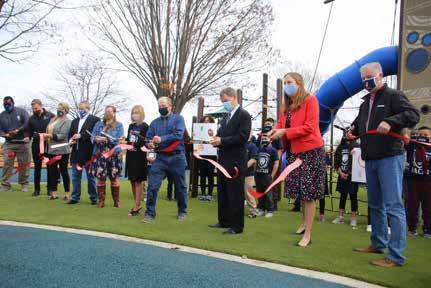
PHOTO COURTESY OF INDY PARKS AND RECREATION
A Tangible Impact on the Community
Never before have parks been as crucial as they are now. The pandemic has altered all of our lives, and time outdoors has been good for us, both physically and mentally. “During the pandemic, parks have been a refuge for our community as parents and children have been working and studying remotely and inside for so long. Parks like this allow us all to get out and enjoy outdoors safely,” says Andre Denman.
“In parks, our goal is always to provide the safest, most relevant, healthiest and most fun experience possible. But with limited funds, it’s hard to refresh our parks as regularly as we would like. So, to be able to give the users of this park all new playground equipment and other amenities is an absolute joy. We can already see that the park is a hit. So, if we’re able to offer some fun, active play, and a sense of community to folks who maybe haven’t felt all those things in 2020, we’re grateful,” says Linda Broadfoot. “It’s been a tough year for everyone. But I think this little corner of the world looks a bit brighter.”
For Cambridge, all the difficulties with this project were well worth it in the end. “This project was as rewarding as it was challenging. Sandorf Park is a great example of how local governments, community groups and the private sector can work collaboratively for the success of parks. In a community still enduring the lingering effects of historical disinvestment and redlining, Sandorf Park will make a tangible impact in the lives of local residents and the city of Indianapolis for years to come.”
Paula M. Jacoby-Garrett is a Freelance Writer located in Las Vegas, Nevada.
ESPORTS:

From Why Do It to How Can I Get Into It?
The future of esports is now
By Neelay Bhatt
When I first wrote about esports for the September 2019 issue of Parks & Recreation magazine (nrpa. org/EsportsTheNextBigThing), the most common questions I heard were: What is esports? Why should we get into it?
The global esports audience growth is projected to be 646 million by 2023.
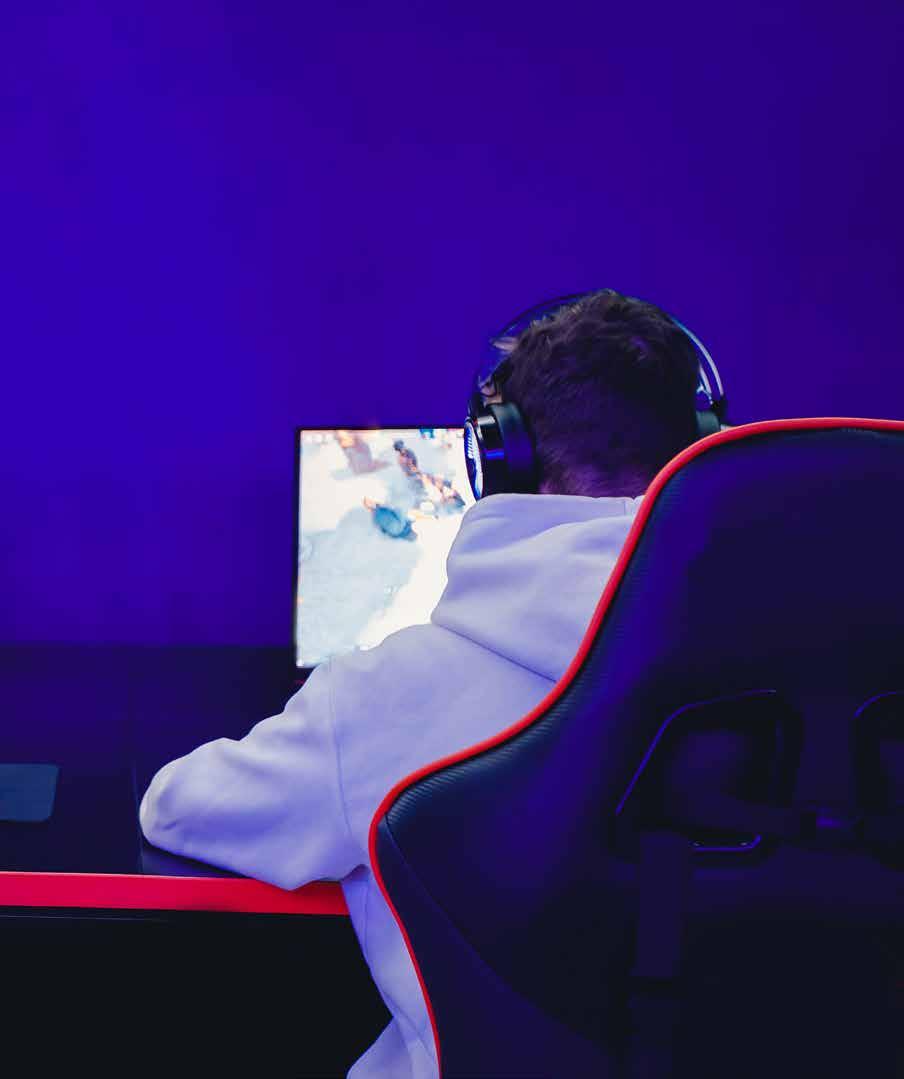
It is a testament to the continued growth of esports (despite the pandemic-related pause of inperson tournaments) that, in less than two years since, the question I hear more often now is: How can we get into esports?
For those still uninitiated into this whole new world of esports, my first article explains that “egaming is a generic term to describe amusement or recreation using a standalone video game, desktop computer or the internet with one or more players, while esports are organized, multiplayer gaming events played in a competitive environment, often by professional gamers. What’s more, spectators watch them in person or via online channels, such as YouTube and Twitch.”
The first esports event happened October 19, 1972 at Stanford University, where students competed on the video game Spacewar. The grand prize for the winner was a 12-month subscription to Rolling Stone magazine, which was won by Bruce Baumgart. Fast forward to 2019, where the top prize for The International 2019: Dota 2 Championships held in Shanghai was $15.6 million.
The Growing Esports Universe
While the coronavirus (COVID-19) pandemic may have limited the audience for in-person esports tournaments, it only resulted in shifting that growth to a streaming audience. Overall, global esports audience growth is projected to be 646 million by 2023. To put that in perspective, that is almost twice the population of the United States.
Twitch, the premier esports streaming platform, experienced a 99 percent viewership increase from October 2019 (839 million hours) to October 2020 (1.6 billion livestreamed hours). Facebook Gaming had 346 million hours watched in August 2020 (tinyurl.com/ y3w32keq). Most major sports, such as basketball and tennis, have deepened their involvement in esports, ranging from NBA 2K20 to Virtual Madrid Open Tennis, respectively. NASCAR has been one of the most successful with its eNASCAR series, attracting a peak of 1.3 million viewers for one race.
Brands and entities like CocaCola, Mercedes-Benz, Adidas and T-Mobile also are growing their investments in esports. Large cities from Philadelphia, Pennsylvania, to Las Vegas, Nevada, to Arlington, Texas, have plans for long-term facility development and growth.
Populous, a global design firm, spans four continents and is deeply involved in purpose-designed esports spaces. According to Senior Architect and Principal Guðmundur Jónsson, “Populous understands the importance of esports as an outlet for a healthy lifestyle and community experience, helping youth develop social skills, strengthen their peer support networks and develop strong social bonds and friendships within recreation centers.”
Senior Architect and Associate Principal Julie Rinaldi shared how the company’s work has included not just developing new facilities (e.g., Fusion Arena for the Philadelphia Fusion), but also retrofitting current facilities (Arlington Convention Center to Esports Stadium Arlington in Texas) to serve growing esports needs.
Victoria Farrar-Myers, deputy mayor pro tempore for Arlington, shared her vision for esports in her city, which is home to the largest dedicated esports stadium in North America. “Esports is an opportunity to raise the global stature of our city that is already known for entertainment and sports. As professional sports innovate, we must

innovate with them to continue serving our community and drive long-term economic development through esports.”
Moment of Zen:
You know the sport is growing when, in a five-year span from 2018 to 2023, its audience is projected to grow by a number equal to 75 percent of the entire population of the United States.
Esports During the Pandemic…and Beyond
For a sport that was poised to grow and hold even larger gatherings and tournaments, COVID-19 ensured things didn’t quite go as planned. However, park and recreation professionals did what they do best: as the year gave them lemons, they made lemonade by pivoting to provide virtual esports offerings or scheduling their esports program plans for 2021. While Excelsior Springs, Missouri, and Hurricane, Utah, have been some of the early providers of esports programs, many others nationwide now have joined them.
NRPA’s Young Professional Network (YPN) provided an extremely informative five-part esports e-learning series and a YPN Conference Cup for Mario Kart Deluxe 8, culminating during the 2020 NRPA Annual Conference: A Virtual Experience.
The Navy Morale, Welfare and Recreation (MWR) team has been particularly active. Based on information provided by John Prue, former installation program director at Naval Station Great Lakes, Illinois, and current MWR program analyst for Navy Region Mid-Atlantic, the Navy Community Recreation (N92) and Fleet and Family Readiness Marketing (N94P) partnered to create the Navy MWR Esports Program to provide sailors with entertainment and recreational opportunities. Big among them was the esports tournament, which consisted of 12 tournaments over 10 weeks and drew 1.55 million live views with nearly 8 million minutes of action watched by a maximum of 43,456 concurrent viewers.
Carlsbad (California) Parks and Recreation Department, a nationally accredited agency, offered a virtual esports tournament in October 2020 that had almost 100 participants. This was the first of many such offerings that they are evaluating for the coming year.
The Florida Recreation and Park Association established the Florida Recreation eSports Council with the aim to form an esports league that can serve agencies statewide.
Looking ahead, park and recreation staff at agencies ranging from Smyrna and South Fulton, Georgia, to Windsor, Colorado, and Boca Raton, Florida, are all set to grow their virtual (and eventually in-person) esports offerings in the new year. Smyrna is looking to build a physical gaming lounge to host live events and tournaments. Richard Garland, Smyrna’s parks and recreation director, states, “We saw esports as an opportunity to provide community and social interaction for all of our citizenry that would still accommodate all the physical distancing require-
The Navy MWR Esports Program provides sailors with entertainment and recreational opportunities.

IMAGE COURTESY OF JOHN PRUE, NAVY MWR
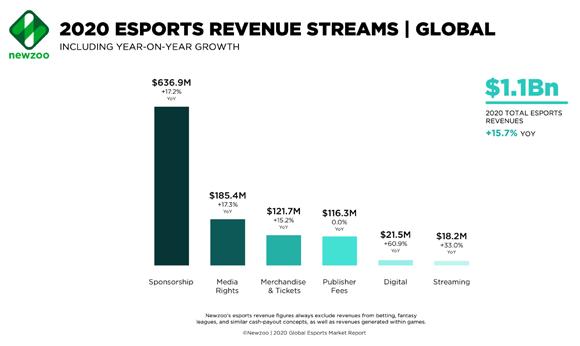
ments we were working under and bring in a potentially untapped new revenue stream for the city.”
Moment of Zen:
There is one sport that is yet to be canceled anywhere due to COVID-19 protocols, and that is esports.
What Can Park and Recreation Professionals Do Next?
1Explore esports partnerships
for program offerings. Based on the National Association of Collegiate Esports, there are more than 170 member schools that are offering more than $16 million in esports scholarships aid. This is an exponential jump from its inception in July 2016 when only seven colleges and universities had varsity esports programs. The Virginia High School League officially approved a one-year pilot program for esports in 2019; it is on its way to becoming fully sanctioned with tournament championship events.
Jim Barnes, deputy village manager for Wellington, Florida, an agency highly focused on equity and inclusion, shares how teens have been the hardest group for them to develop programming for. “Esports is an opportunity to get teens back in the fold and to create an inclusive environment where age and physical ability don’t impact participation,” says Barnes.
For park and recreation professionals who are not sure how to begin or lack the expertise, exploring existing esports clubs through schools and colleges in and around your communities can help. There’s existing knowledge and a built-in affinity group that could help get your offerings started and reach the primary target audience.
Additionally, global sponsorship revenue in 2020 alone was almost $637 million. In addition to existing fitness, wellness and outdoor adventure brands, the technology and gaming sector could be a whole new category of sponsors and earned income for parks and recreation in the years to come.
2Develop dedicated facility space (new or retrofitted) for
esports. Not everyone can have an Arlington-style 100,000-squarefoot facility (after all, don’t they say, “Everything’s bigger in Texas”?), but that should not stop you from looking at creating dedicated spaces for esports. National Gold Medal agencies, such as Westerville, Ohio, and Park District of Oak Park, Illinois, are designing facilities with dedicated spaces for esports.
Westerville’s dedicated esports facility is set to open in early 2021 (based on COVID-19 safety protocols) as a part of its $20 million community center expansion project. Randy Auler, director of Westerville Parks and Recreation (WPRD), states, “WPRD esports is where individuals can gather both virtually and in person to enhance and develop the skills necessary to not only compete against
PHOTO COURTESY OF BRYCE KING, HURRICANE RECREATION AND LEISURE SERVICES Hurricane (Utah) Recreation and Leisure Services undertook a creative and costeffective method to retrofit existing unused storage space into a newly painted and reconfigured dedicated esports space.
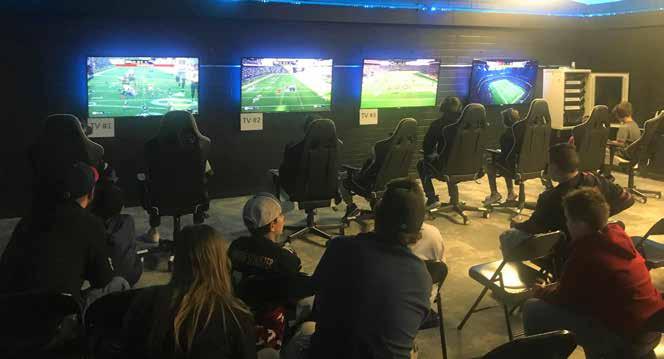
Carlsbad (California) Parks and Recreation Department offered a virtual esports tournament in October 2020 that had almost 100 participants.
other esport athletes, but [also] provide them tools to pursue a career in esport game design, computer software development and coding. This is truly a one-of-a-kind STEM program offering.”
Hurricane Recreation and Leisure Services, led by its director, Bryce King, undertook a creative and cost-effective method to retrofit existing unused storage space into a newly painted and reconfigured dedicated esports space with support from staff, local partners and donors. This space continues to grow, hosting a variety of events from birthday parties to Madden NFL 20 virtual leagues.
3Target local Influencers to promote parks and recreation.
Viya (the stage name of Huáng Wˉei), a streamer from the Chinese platform Taobao, generated almost $50 million in one day by promoting products during a livestream. In May 2020, she hit a record-high audience of more than 37 million — more than the Game of Thrones finale, the Oscars or Sunday Night Football.
With more than 10 million followers, Viya may be a one-ofa-kind influencer in the world of “ecommerce livestreaming,” but the rise of streamers-turnedinfluencers is helping to expand the reach of esports while reducing the stigma of being a gamer. Consumer brands now want to associate with esports players, and that trend is likely to continue as brands try to reach the younger audience invested in esports.
Park and recreation professionals should look for those streaming influencers in your communities or who may have a connection to your community. These individuals have the potential to become your advocates to the next generation, not just for esports but for parks and recreation as a whole.
IMAGE COURTESY OF MIKE PACHECO, CARLSBAD PARKS AND RECREATION
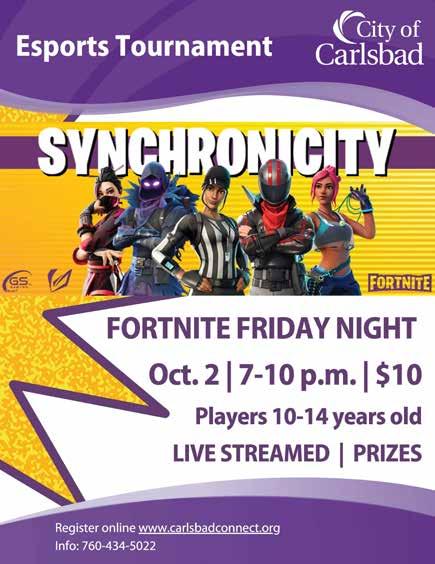
Moment of Zen:
Stories abound about the Seat Pleasant Activity Center’s (Prince George’s County [Maryland] Parks and Recreation) impact on Kevin Durant’s life and basketball story growing up. Imagine the same story narrated in 10 years of an Esports World Champion or Olympic Gold Medalist who grew up playing Fortnite, Mario Kart or League of Legends in your recreation center.
What Does the Future Hold?
What was once a niche is now mainstream. Esports will continue to be one of the biggest growth stories of the coming decade. From livestream shopping to global leagues and from virtual realitybased gaming to using artificial intelligence to improve sport performance, the sky is the limit.
I strongly believe that parks and recreation is the greatest connector for our communities. In a world that seems more divided than ever before, maybe esports can become the great uniter.
Neelay Bhatt is Principal at PROS Consulting Inc. and a Member of Parks & Recreation magazine’s Editorial Advisory Board (neelay. bhatt@prosconsulting.com).









